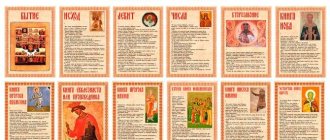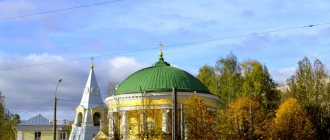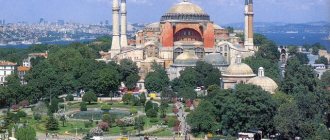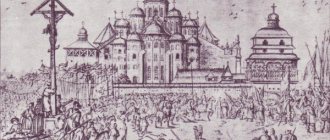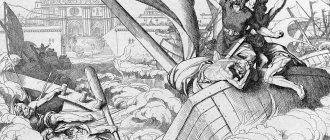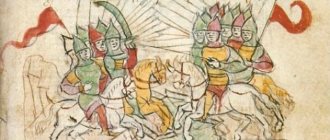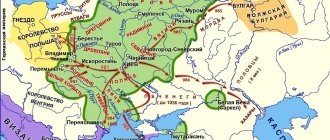| "Holy 8th Ecumenical Council (879-880)". Hellas. Meteora. Monastery of St. Stefan. The porch of the Catholicon in honor of St. Harlampy. Wall painting. Icon painter - Blasius Tsotsonis (Βλάσης Τσοτσώνης), 21st century. |
Council of Constantinople 879-880
, at which the decisions of the previous Council of 869-870 were canceled, and representatives of the Roman Church recognized Patriarch Photius of Constantinople. At this Council there were representatives of all five patriarchal thrones, so it can claim the status of Ecumenical. The Council adopted a number of canonical rules, and also condemned any additions to the Nicene-Constantinopolitan Creed
- On the map: Yandex.Map, Google map (no exact coordinates)
The condemnation of Patriarch Photius and his supporters by the Council of 869-870 not only did not bring reconciliation, but also further aggravated church contradictions within the Byzantine Empire between supporters of St.
Photius and St. who returned to the throne. Ignatius. Moreover, the harsh form in which the repeal of the decisions of the Council of Constantinople of 867 and the ultimatum demand for a written expression of loyalty to Rome (libellus satisfactionis) from all bishops of the Church of Constantinople was carried out, caused discontent not only of the Photians, but also of the moderate Ignatians. The massive condemnation of Photius' "minions" led to the defrocking of a huge number of clergy (about 200 bishops were condemned), so that a shortage of clergy began to be felt. The issue with Greek missionaries among the recently baptized Bulgarians and “Russians” arose especially acutely: they were sent to preach by Photius and now found themselves under a canonical ban. In these circumstances, imp. Vasily I and Patriarch Ignatius decided to soften church policy. In 871, an embassy was sent to Rome, headed by one of the Ignatian leaders, Mon. Theognostom. But both Pope Adrian II and John VIII, who replaced him in December 872, did not want to hear about relaxations for the “Photians,” and they considered the spread of Christianity in Bulgaria solely their prerogative. Rome pointed out that since ancient times, the territory of the entire Balkan Peninsula, with the exception of the area closest to Constantinople, belonged to the jurisdiction of the Roman Church. Pope John VIII threatened Patriarch Ignatius with canonical reprimands because, in encroaching on Bulgaria, he was behaving “worse than Photius” [1].
Things were again heading towards a church break, and in order to avoid this, imp. Vasily invited the pope to discuss all controversial issues at a new “general council.” John VIII, who was experiencing political difficulties in relations with neighboring princes and sought to maintain a strong ally in the eastern emperor, agreed to the proposal. Legates, Bishops Paul of Ancona and Eugenius of Ostia, were sent to Constantinople with harsh messages to the Greeks and Bulgarians. Bulgarian book The pope called on Boris (Michael) and his brother Peter to return to the bosom of the Roman Church, which alone is capable of protecting them from heresies; He declared Greek missionaries in Bulgaria excommunicated, and demanded that the patriarch recall his clergy from Bulgaria within 30 days, threatening with excommunication.
In October 877, Patriarch Ignatius died and St. was re-erected in his place. Photius. The legates arrived in Constantinople unaware of these changes. They refrained from communicating with the new patriarch until they received instructions from Rome. An embassy was sent to the pope with letters from the emperor, Patriarch Photius and the Byzantine clergy, in which requests were expressed for recognition of the unanimously elected primate of the Church of Constantinople. John VIII convened the Roman Council, at which he announced the forgiveness and recognition of Photius on the condition of his public repentance, reconciliation with the “Ignatians” and renunciation of missionary activity in Bulgaria. The new ambassador, Cardinal-Presbyter Peter, delivered papal messages to Constantinople to the emperor, the clergy and patriarchs of the Eastern Churches, Photius and the supporters of Ignatius, as well as special instructions (commonitorium) for the legates [2].
The study of the Council is complicated by source study problems. Firstly, the text of the mentioned papal epistles (except for the letter to the “Ignatians”) has been preserved in two versions, Latin (in the Register of John VIII, known from the only manuscript of the second half of the 11th century from Monte Cassino) and Greek (in conciliar acts), which differ significantly from each other; the instructions were preserved only in the version read at the Council [3]. Greek the version is much softer in its expression of papal demands, especially regarding the termination of the Bulgarian mission. It also contains a prohibition to refer to the acts of the “anti-Photian” Councils, which is absent in the Latin text. The instructions to the legates also state that the Council of 869-870 “should not be counted among the other holy Councils of the Church” (chapter 10). Most likely, changes to the text of the letters were made already in Constantinople during the preparation of the Council, possibly with the knowledge of the legates, to whom the pope granted a certain freedom of action on the situation [4]. Secondly, Greek. The handwritten tradition of conciliar acts is very extensive and varied. In different manuscripts (the oldest of which dates back to the 13th century, and the majority to the 15th-16th centuries), not only the text varies, but also the number of conciliar acts (from 4 to 7). This raises the question of the authenticity of the text of the conciliar acts, which cannot be considered finally resolved until the publication of a critical edition. Most researchers are inclined to recognize the authenticity of all 7 acts [5].
Council meetings opened in early November 879 in the gallery of the Church of St. Sophia. According to the acts, they were attended by 383 bishops (it is possible, however, that this number refers to the total number of bishops who signed the acts), including representatives of all five patriarchal thrones, this gave the Council the status of “ecumenical”. Imp. Vasily I was not present (which can be explained by mourning for his eldest son Constantine, who died suddenly on the eve of the opening of the Council [6]). The first meeting was devoted to ceremonial greetings. The legates, on behalf of the pope, called on those gathered to restore peace and unity in the Church, to which the bishops responded that they had long had “a single shepherd - our most holy ruler, Ecumenical Patriarch Photius.” Metropolitan Zechariah of Chalcedon noted in his speech that the Council was convened “for the sake of the good name of the Roman Church,” which was endangered due to the fact that, on the basis of one-sided and unreliable information about events in the East, Rome made inadequate decisions. At the end of the meeting, the legates presented St. Papal gifts to Photius - episcopal vestments, pallium (omophorion), albu (surplice), casulu (felonion) and shoes - thereby recognizing his patriarchal dignity [7].
The second meeting took place on November 17, 879. It opened with a short liturgy with the legates singing parts of the service in Latin. Then the messages of the pope and the eastern patriarchs were read out. At the request of the legates of St. Photius spoke about the circumstances of his second elevation to the patriarchal throne, pointing out that he was not the initiator of this act, but there was no pressure from the emperor. Especially St. Photius mentioned his reconciliation with the late St. Ignatius.
The third meeting, on November 19, began with the reading of a letter from the pope to the bishops of all the Eastern Churches, in which John VIII insisted on the inadmissibility of elevating laymen to the bishopric (at one time this was one of the main accusations against Photius). In the debate that followed, the bishops objected to this approach, seeing it as interference in the internal affairs of the Church of Constantinople. Then the message of Theodosius, Patriarch of Jerusalem, was read, which questioned the legitimacy of the representatives of the East at the Council of 869-870. In this regard, the pope's legates began to ascertain the powers of the present delegates from the Eastern patriarchs and were convinced of their legality and impartiality. At the end, the legates testified that “Constantinople for many years did not know such a man as Photius,” and began to read parts of the instructions they received from the pope and the Roman Council (Commonitorium).
The fourth meeting took place after a long break, on December 24. In view of the approaching Christmas, the bishops gathered not in St. Sophia, but in the room of the “great secret”. The meeting began with the acceptance of letters from Metropolitan. Basil of Martiropol, a representative of Antioch, who arrived at the Council with messages from the new Patriarch of Jerusalem Ilia III. Then the case of two patricians was considered, who refused to enter into communication with Patriarch Photius, but subsequently repented and received the due penance. The rest of the time was devoted to discussing the instructions of the papal legates. The “Bulgarian question” (chapter 9) was immediately postponed, as being entirely within the competence of the emperor. The pope's objections to the ordination of the laity (chap.) were challenged on many examples, after which it was pointed out that if such a prohibition exists in the Roman Church, this does not mean that it should be imposed on others. Cancellation of the decisions of the Council 869-870 (ch. 10 ) was greeted with jubilation. Finally, Card Peter was invited to concelebrate with Patriarch Photius at the Christmas service.
In view of the approaching Christmas, the bishops gathered not in St. Sophia, but in the room of the “great secret”. The meeting began with the acceptance of letters from Metropolitan. Basil of Martiropol, a representative of Antioch, who arrived at the Council with messages from the new Patriarch of Jerusalem Ilia III. Then the case of two patricians was considered, who refused to enter into communication with Patriarch Photius, but subsequently repented and received the due penance. The rest of the time was devoted to discussing the instructions of the papal legates. The “Bulgarian question” (chapter 9) was immediately postponed, as being entirely within the competence of the emperor. The pope's objections to the ordination of the laity (chap.) were challenged on many examples, after which it was pointed out that if such a prohibition exists in the Roman Church, this does not mean that it should be imposed on others. Cancellation of the decisions of the Council 869-870 (ch. 10 ) was greeted with jubilation. Finally, Card Peter was invited to concelebrate with Patriarch Photius at the Christmas service.
At the fifth meeting, January 26, 880, practical issues were considered. St. Photius made a proposal to confirm the authority of the Council of 787 against the iconoclasts and include it in the number of Ecumenical Councils - which was accepted with the consent of the papal legates. This decision, made in 869-870, once again disavowed the Antiphotian Council. Then a decision was made in the case of one of the Ignatian leaders, Metropolitan. Mitrofan of Smirnsky. He did not recognize St. Photius, and the council delegation sent to him replied that he was ill and could not come to the Council. The papal legates did not consider this a valid reason, excommunicating Mitrofan from the Roman Church.
In this regard, the Council adopted a canonical rule on the mutual validity of excommunications, eruptions and anathemas imposed by the Pope and the Patriarch of Constantinople. Mitrofan was again called to reunification by Patriarch Photius and, after his refusal, was excommunicated by the Council on the basis of this canon. The second rule prohibited bishops from arbitrarily retiring to monasteries for monastic life, and those who did this were deprived of the right to return to the pulpit. The third rule imposed an anathema on laymen who dared to beat or imprison bishops - both without guilt and under pretexts of guilt. All three rules of the “Council in the Temple of Wisdom - the Word of God” were included in the collections of canon law of the Orthodox Church.
After this, the bishops, at the invitation of the legates, signed the conciliar acts.
The sixth meeting took place in the Grand Palace on March 3, 880. It was attended by imp. Basil I and representatives of the Council - 22 bishops. In a brief speech, the emperor said that he was absent from the meetings so as not to restrict in the slightest way the freedom of action of the bishops, and proposed to capture the unanimity achieved at the Council with the words of the Nicene-Constantinople Creed. Which is what was done. Moreover, any additions to the Symbol were condemned, which, of course, meant the Filioque. After this, Vasily and his sons, Lev and Alexander, signed the conciliar acts, giving them official status.
On March 13, the bishops gathered for the last time in the Church of St. Sophia for a solemn final meeting. The legates announced the recognition of St. Photius and threatened with excommunication anyone who refused to enter into communication with him. All participants joined them.
The fact that neither the legates nor subsequently Pope John VIII had anything against condemning changes to the Creed proves that at the time in question the practice of adding the Filioque was not widespread in the Roman Church and was considered a marginal Frankish tradition. This is also evidenced by the message of Pope John VIII, attached to the acts in the Greek translation [8]. In it, the pope, in rather harsh terms, condemns any distortions of the Symbol, but calls on St. Photius to patience and persistent joint work to eradicate this “innovation.” However, the authenticity of this message remains in question: it is unclear how such a strong argument against the Filioque could remain unnoticed in the centuries-long polemics on this issue between East and West.
Subsequently, Latin writers subjected the Council of 879-880 to severe criticism, seeing in it a derogation of the dignity of the Roman Church, and highlighted the Council of 869-870, which was established in the Catholic tradition as the “8th ecumenical”. Many Orthodox theologians, on the contrary, consider the Council of 879-880 so important for the history of the Church that they call for its inclusion in the number of Ecumenical Councils.
Reverence
The Greek icon painter Blasius Tsotsonis (Βλάσης Τσοτσώνης) at the beginning of the 21st century created a fresco dedicated to the Council of 879-880 in the monastery of St. Stephen in Meteora, in the narthex of the Catholicon in honor of St. Charalampia. Her image was published in the book “Stone Forest” by the Greek nun Theotekni Agiostephanitissa [9].
In the Metropolis of Piraeus, nun Thekla Agiostephanitissa composed the service of St. fathers of the VIII Ecumenical Council [10] and in the first week of February, with the blessing of Metropolitan of Piraeus. Seraphim (Mendzelopoulos) she serves in the monastery of St. Stefan in Meteora.
Confusion and vacillation
In those days, the ordinary Byzantine man in the street was pious and strictly observed church rituals. The iconoclasts flaunted their indifference to them. Anyone who spent nights in the temple in prayer was already considered unreliable by them. And participating in revelry, swearing and swearing, shaving your beard was good manners. Breaking with traditions and entering into the fight against icon veneration, the iconoclast emperors wanted, without seeming to renounce Christianity, to reduce its visible presence in the life of society to a minimum.
Emperor Justinian with his retinue. Mosaic from the Church of San Vitale in Ravenna. Before 547
In fact, crude pagan veneration of images was alien to the Fathers of the Church. When Constance, the half-sister of Emperor Constantine the Great, asked the church historian Eusebius of Caesarea where one could find an image of Christ that captured His bodily image, he replied that every Christian should carry His true image in his heart. And Seren, Bishop of Marseilles, in 598, seeing that his flock was already literally deifying the icons, tore them off and threw them out of the church, which created a great temptation among the people. But when news of this reached Pope Gregory the Great, he sent a message to Serenus in which... he praised him for his jealousy, although not for his reason. True, he immediately demanded to “calm down the temptation” created in the flock: to return to the temple the icons that “were given to illiterate people instead of books,” and to explain to the people how to properly honor them.
Of course, there were reasons for concern, although often the reason for everything was the warm faith of children. Saint Theodore the Studite not only did not condemn, but even praised one nobleman who chose the icon of the Great Martyr Demetrius as godfather to his son.
But more often than not, the church rite itself was grossly distorted and the celebration of icons actually came close to idolatry. Therefore, in the East, there were bishops like Seren of Marseilles, who believed that neither faith nor the veneration of saints would suffer from the abolition of icons, but that church rites would come closer to the ideal of worshiping God in spirit and truth.
Literature
- Δοσίθεος, Πατρ. Τόμος χαρᾶς. ῾Ρῆμνης, 1705. S. 33-102 [acts];
- Mansi. T. 17. Col. 373-524 [acts, ed. Ardoin according to the Vatican RCP].
- Hergenröther J. Photius, Patriarch von Konstantinopel: Sein Leben, seine Schriften und das griechische Schisma. Regensburg, 1867. Bd. 1; 1868. Bd. 2; 1869. Bd. 3;
- Ivantsov-Platonov A. M., prot. To research about Photius, Patr. Constantinople // ZhMNP. 1892. Dept. 2. Part 280. No. 3. P. 121-148; Part 281. No. 5. P. 1-72; No. 6. P. 299-315; Part 283. No. 9. P. 1-60; No. 10. P. 205-251 (department: St. Petersburg, 1892);
- Grumel V. Le “Filioque” au concile photien de 879-880 et le témoignage de Michel d'Anchialos // EO. 1930. T. 29. N 159. P. 257-264;
- idem. Le décret du synode photien de 879-880 sur le Symbole de foi // Ibid. 1938. T. 37. N 191/192. P. 357-372;
- idem. Les lettres de Jean VIII pour le rétablissement de Photius // Ibid. 1940. T. 39. N 197/198. P. 138-156;
- idem. La VIe session du concile photien de 879-880: A propos de la mémoire liturgique, le 3 septembre, de l'empereur Constantin le Nouveau // AnBoll. 1967. T. 85. Fasc. 3/4. P. 336-337;
- Laurent V. Le cas de Photius dans l'apologétique du patriarche Jean XI Beccos (1275-1282) au lendemain du IIe concile de Lyon // EO. 1930. T. 29. N 160. P. 396-415;
- idem. Les actses du synode photien et Georges le Metochite // Ibid. 1938. T. 37. N 189/190. P. 100-106;
- Jugie M. Les actses du Synode photien de Sainte-Sophie (879-880) // Ibid. P. 89-99;
- Hofmann G. Lo stato presente della questione circa la riconciliazione di Fozio con la Chiesa Romana // Civiltà Cattolica. R., 1948. T. 99. N 3. P. 51-55;
- Dvornik F. The Photian Schism: History and Legend. Camb., 1948;
- idem. The Patriarch Photius in the Light of Recent Research // Berichte zum XI. Intern. Byzantinisten-Congress. Münch., 1958. Bd. 3/2. S. 1-56;
- Stiernon D. Constantinople IV. P., 1967;
- Ogitsky D. P. K-Polish Councils of 869-870 and 879-880. and church modernity // ZhMP. 1969. No. 12. P. 62-66 (Same // VRZEPE. 1969. No. 68. P. 218-227);
- Stephanou PE Deux conciles, deux ecclesiologies?: Les conciles de Constantinople en 869 et en 879 // OCP. 1973. Vol. 39. N 2. P. 363-407;
- Meijer J. A Successful Council of Union: A Theol. Analysis of the Photian Synod of 879-880. Thessal., 1975;
- Peri V. Il concilio di Constantinopoli dell' 879-80 come problema filologico e storiografico // AHC. 1977. Bd. 9. S. 29-42;
- idem. Il ristabilimento dell'unione delle Chiese nell' 879-880: Il concilio di Santa Sofia nella storiografia moderna // Ibid. 1979. Bd. 11. P. 18-37;
- Van Bunnen A. Un centenaire oublié: le concile de Constantinople de 879-880 // Contacts. P., 1981. T. 33. N 113. P. 6-40; N 115. P. 211-234;
- Boojamra JL The Photian Synod of 879-80 and the Papal Commonitorium (879) // ByzSt. 1982. Vol. 9. P. 1-23;
- Somenok G., prot. Holy Patriarch Photius and the great Sophia Cathedral 879-880. // TKDA. 1997. No. 1. P. 79-88;
- Dragas GD The 8th Ecumenical Council: Constantinople IV (879/880) and the Condemnation of the Filioque addition and Doctrine // GOTR. 1999. Vol. 44. P. 357-369;
- Lebedev A.P. History of the K-Polish cathedrals of the 9th century. / Ed.: M. A. Morozov. St. Petersburg, 2001. pp. 189-296;
- Thümmel HG Die Konstantinopeler Konzilien des 9. Jh.: Eine Übersicht // AHC. 2005. Bd. 37. S. 437-458.
Eighth Ecumenical Council
Pan-Orthodox Conference ("Pan-Orthodox Congress") Πανορθόδοξον Συνέδριον, original name - "commission of Orthodox Churches" (May 10 - June 8, 1923) - a meeting in Constantinople convened by Meletios Metaxakis. The first stage of radical reforms of Orthodoxy, the first organizational step in the preparation of the Eighth Ecumenical Council.
On February 3, 1923, Meletius Metaxakis addressed a message to the Primates of the Orthodox Churches of Alexandria, Antioch, Jerusalem, Serbia, Cyprus, Greece and Romania, in which he proposed to gather in Constantinople and “study the calendar issue and other pressing pan-Orthodox problems and indicate a method for their canonical resolution " Representatives of the Patriarchs of Alexandria, Antioch and Jerusalem refused to participate in the meeting.
Pan-Orthodox Congress. Participants
Participants of the “congress” The following
took part in 11 meetings: Meletios Metaxakis, Metropolitan. Kallinikos (Delicanis), Basil Antoniadis (Patriarchate of Constantinople); Metropolitan Gabriel (Dozic, future Patriarch of Serbia), Milutin Milankovic (Serbian Church); Metropolitan Basil (Georgiadis, future Patriarch of Constantinople) (Church of Cyprus); Metropolitan Jacob of Dyrrhachium (Mytilene) (Greek Church); archim. Julius (Scriban), Petr Drangic, D. Dimitrescu (Romanian Church); archbishop Anastasy (Gribanovsky) (present at the first 6 meetings), Archbishop. Alexander (Nemolovsky) (Russian Church).
Congress Topics
reform of the church calendar
The main proponent of calendar reform was Meletios Metaxakis, who, starting in 1919, prepared the reform with the ultimate goal of celebrating Church holidays together with Catholics and Protestants. Three options for changing the calendar were proposed:
- add 13 days to the Julian calendar;
- switch to the “New Julian” calendar of Milutin Milankovitch (Milankovitch’s calendar coincides with the Gregorian calendar until 2800);
- go to P. Drangich's calendar.
possibility of moving major holidays to the nearest Sundays
marriage
At the “congress”, issues were discussed about the second marriage of the clergy and the marriage of already ordained clergy, about the admissibility of a second marriage for widowed priests and deacons, about the episcopal degree and marriage. Metropolitan Gabriel (Dozic) asked the “Pan-Orthodox Congress”, for reasons of “economy,” to allow widowed clergy to enter into a second marriage, allowing this deviation from the canonical rules as a temporary measure until the convening of the Pan-Orthodox Council.
The issues of canonical obstacles to marriage, reasons for divorce, possibilities and conditions for mixed marriages were also considered.
reduction of religious services
review of fasting rules
frequency of convenings of Pan-Orthodox Councils
on age limits for those ordained as deacon, priest and bishop
on the accession of Catholic clergy to Orthodoxy and the possibility of their marriage
about the appearance and clothing of clergy
ecumenism
It was also proposed to consider the problems of ecumenism and make decisions on the possibility of uniting the Orthodox Church with Catholics and Anglicans.
Eighth Ecumenical Council
A proposal was discussed to convene the Eighth Ecumenical (Pan-Orthodox) Council in 1925, coinciding with the 1600th anniversary of the First Ecumenical Council.
Orthodox diaspora
The problem of the jurisdiction of Local Churches over diasporas was explored.
Pan-Orthodox Congress. Definitions
At the “Pan-Orthodox Congress” 7 definitions were adopted.
Calendar reform
The “Pan-Orthodox Congress” decided to recommend that Local Churches adopt the Gregorian calendar under the name “New Julian”, but over time switch to the Drangich calendar after its scientific and ecclesiastical consideration and approval.
The “Pan-Orthodox Congress” decided to count October 1, 1923 as October 14, and holidays falling on the missed days were recommended to be celebrated all together on October 14, or to leave this issue to the discretion of the ruling bishops.
In the 2nd definition, the “Pan-Orthodox Congress” noted the readiness of its participants to accept any calendar, even if it does not maintain the division of the week into seven days. The “Pan-Orthodox Congress” announced its readiness to celebrate Easter as a fixed holiday on a specific Sunday, if Catholics and Protestants agree, with the wish that “this fixed Sunday would correspond to the actual day of the Resurrection of the Lord, determined through scientific methods.”
“In order to reduce the number of non-working days,” the calendar reform provided for celebrating Church holidays only on Sunday. Before the adoption of this revolutionary resolution by the Eighth Ecumenical Council, Local Churches had to independently decide each individual case of celebrating the memory of saints on weekdays.
marriage
Before the convening of the Eighth Council, the “Pan-Orthodox Congress” proclaimed the possibility of priests and deacons entering into marriage after ordination, excluding those who had accepted monasticism. The “Pan-Orthodox Congress” also declared remarriage permissible for widowed priests and deacons until the convening of the Pan-Orthodox Council.
The “Pan-Orthodox Congress” left obstacles to marriage within the framework of the canons of the Ecumenical Councils, but gave the Local Churches the right to deviate from the strictness of the canons. This technique will subsequently be widely used in preparing the reform of Orthodoxy at the Eighth Ecumenical Council: the canons are not officially changed, but individual Churches, bishops and confessors are given the right to deviate from the canons in the spirit of the times.
age for ordination
The “Pan-Orthodox Congress” set the lower limit of the age for ordination to the deacon at 21 years, to the priesthood - 24 years, to the bishop - 30 years; monastic vows must be taken at the age of at least 25 and observed for life.
appearance of clerics
The “Pan-Orthodox Congress” approved the “toning of hair” by clergy and their wearing of secular clothing outside the church.
Photo from the newspaper Νέος Κόσμος June 16, 1935
fast
The “Pan-Orthodox Congress” called for observing fasting, while allowing indefinitely wide opportunities for “oikonomia”, i.e. violations of fasting.
Eighth Ecumenical Council
The “Pan-Orthodox Congress” decided to convene the Eighth Ecumenical (Pan-Orthodox) Council in 1925, at which the reforms of the “congress” would be approved, and also approved the plan for celebrations associated with the celebration of the 1600th anniversary of the First Ecumenical Council.
about the persecution of the Russian Church
Concluding its work, the “Pan-Orthodox Congress” adopted a special definition regarding the persecution of the Russian Church and the arrest of Patriarch Tikhon.
Pan-Orthodox Congress. Consequences
The decisions of the “Pan-Orthodox Congress” were initially rejected by the Patriarchates of Alexandria, Antioch and Jerusalem. Serbian Patriarch Dimitri, as well as the Primate of the Cyprus Church, Archbishop. Kirill declared their readiness to make a decision on calendar reform, but only subject to its approval by all Local Churches.
Immediately after the “Pan-Orthodox Congress”, the Constantinople, Romanian and Greek Churches switched to the “New Julian” calendar, then they were joined by the Alexandrian, Antiochian, Bulgarian, Cypriot and Albanian Churches. The Orthodox Church of the Czech Lands and Slovakia, as well as the Orthodox Church of Poland, use two calendars.
In 1923-24 the new style was temporarily introduced in the Russian Orthodox Church and among the Renovationists.
In the Greek and Romanian Churches, the introduction of a new style caused a split in the 1920s, and decades later - in the Bulgarian and Serbian Churches.
Sources
Acts and Decisions of the “Pan-Orthodox” Congress of 1923 in Constantinople // https://holyrussia.narod.ru/Kongress.html 04/16/2014 Seraphim (Sobolev), Archbishop. On the old and new style: Report // Meeting, 1948. Acts. T. 2. P. 305-317 Seraphim (Sobolev), archbishop. Orthodox view of the old and new calendar style. Sofia, 1972 Old style and the Greek Church // Journal of the Moscow Patriarchate. 1952. No. 11. P. 49-53 Troitsky, S.V. Let us fight the danger together // Journal of the Moscow Patriarchate. 1950. No. 2. P. 36-51 Photius (Siromakhov), bishop. The beginning of apostasy: the “Pan-Orthodox” congress of 1923 and its consequences // Moscow. 1996. No. 5. P. 196-203 Photius (Siromakhov), bishop. A fatal step towards retreat: to the 70th anniversary of the “Pan-Orthodox” Congress in Constantinople // Orthodox Rus'. 1994. No. 1. P. 7-10; No. 6. P. 6-8; No. 7. P. 9-11 Yakimchuk, I. Z. “Pan-Orthodox Congress” // Orthodox Encyclopedia. M.: Tserkovno-nauchny, 2005. T. 9. P. 680-683 Φιλοθεου Ζερβακο // Κρυφό Σχολειό. https://krufo-sxoleio.blogspot.ru/2012/09/blog-post_9243.html 09/05/2012 Dimitrijevic, MS; Theodossiou, E. The calendar of the Greek Orthodox Church // Archive of Astronomical and Astrophysical Transactions. 2002. V. 21. No. 1–3. P. 145-147 Milankovitch, M. Das Ende des julianischen Kalenders und der neue Kalender der orientalischen Kirchen // Astronomische Nachrichten. 1924. V. 220. P. 379-384 Milutin Milankovic world famous scientist from Belgrade University. Reform of the Julian Calendar // University library “Svetozar Markovic”. https://unilib.bg.ac.rs/eng/about_us/exhibitions/milankovic_virtual/reforma.php 04/14/2014 Shields, Miriam Nancy. The new calendar of the eastern churches // Popular Astronomy. 1924. V. 32. P. 407-410 Viscuso, Patrick. A quest for reform of the Orthodox Church. The 1923 Pan-Orthodox Congress: an analysis and translation of its acts and decisions. Berkeley, Calif.: InterOrthodox Press, 2006
Share link:
- Send this to a friend (Opens in new window)
- Click to print (Opens in new window)
- Click to share on Twitter (Opens in new window)
- Click here to share content on Facebook. (Opens in a new window)
- Click to share on LinkedIn (Opens in new window)
- Click to share on Pinterest (Opens in new window)
- Click to share posts on Pocket (Opens in new window)
- Click to share posts on Tumblr (Opens in new window)
- Click to share on Reddit (Opens in new window)
Liked this:
Like

